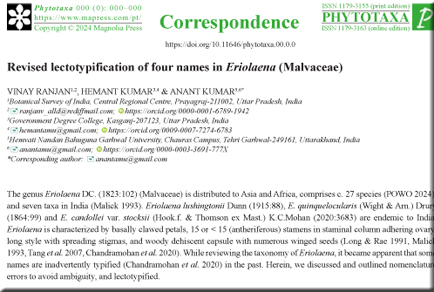Abstract
The genus Eriolaena DC. (1823:102) (Malvaceae) is distributed to Asia and Africa, comprises c. 27 species (POWO 2024), and seven taxa in India (Malick 1993). Eriolaena lushingtonii Dunn (1915:88), E. quinquelocularis (Wight & Arn.) Drury (1864:99) and E. candollei var. stocksii (Hook.f. & Thomson ex Mast.) K.C.Mohan (2020:3683) are endemic to India. Eriolaena is characterized by basally clawed petals, 15 or < 15 (antheriferous) stamens in staminal column adhering ovary, long style with spreading stigmas, and woody dehiscent capsule with numerous winged seeds (Long & Rae 1991, Malick 1993, Tang et al. 2007, Chandramohan et al. 2020). While reviewing the taxonomy of Eriolaena, it became apparent that some names are inadvertently typified (Chandramohan et al. 2020) in the past. Herein, we discussed and outlined nomenclature errors to avoid ambiguity, and lectotypified.
References
- Chandramohan, K., Mahesh, Y., Rambabu, K. & Kiran, E. (2020) A taxonomic revision of the genus Eriolaena (Malvaceae) in India. Annals of Plant Sciences 9 (1): 3681–3692.
- De Candolle, A.P. (1823) Sur quelques Genres nouveaux de la Famille des Buttneriacees. Mémoires du Museum d’Histoire Naturelle 10: 97–115.
- De Candolle, R. & Smith, A.R. (1981) Nathaniel Wallich, MD, PhD, FRS, FLS, FRGS, (1786–1854) and the Herbarium of the Honourable East India Company, and their relation to the de Candolles of Geneva and the Great Prodromus. Botanical Journal of the Linnean Society 83: 325–348. https://doi.org/10.1111/j.1095-8339.1981.tb00355.x
- Dorr, L.J. (2014) The correct author citation of the combination Eriolaena quinquelocularis (Malvaceae: Dombeyoideae) and typification of its basionym. Taxon 63 (6): 1340–1341. https://doi.org/10.12705/636.2
- Drury, H. (1864) Handbook of the Indian Flora; being a guide to all the flowering plants hitherto described as indigenous to the continent of India, Vol. 1. Tribancore Sircar Press, 659 pp. https://doi.org/10.5962/bhl.title.54658
- Dunn, S.T. (1915) Decades Kewenses: Plantarum Novarum in Herbario Horti Regii Conservatarum. Bulletin of Miscellaneous Information, Royal Gardens, Kew 1915 (2): 88–93. https://doi.org/10.2307/4107497
- Long, D.G. & Rae, S.J. (1991) Sterculiaceae. In: Grierson, A.J.C. & Long, D.G. (Eds.) Flora of Bhutan, Vol. 2. Royal Botanic Garden, Edinburgh, pp. 195–208.
- Malick, K.C. (1993) Sterculiaceae. In: Sharma, B.D. & Sanjappa, M. (Eds.) Flora of India, Vol. 2. Botanical Survey of India, Calcutta, pp. 407–476.
- Masters, M.T. (1874) Eriolaena. In: Hooker, J.D. (Ed.) Flora of British India, Vol. 1. L. Reeve & Co., London, pp. 370–371.
- POWO (2023) “Plants of the World Online. Facilitated by the Royal Botanic Gardens, Kew. Published on the Internet. Available from: http://www.plantsoftheworldonline.org (accessed 28 February 2024)
- Stafleu, F.A. & Cowan, R.S. (1976) Taxonomic Literature: A Selective Guide to Botanical Publications and Collections with Dates, Commentaries and Types (Second edition, Vol. 1). Bohn, Scheltema, and Holkema, Utrecht, 1136 pp. https://doi.org/10.5962/bhl.title.48631
- Tang, Y., Gilbert, M.G. & Dorr, L.J. (2007) Sterculiaceae. In: Wu, Z. & Raven, P.H. (Eds.) Flora of China, Vol. 12. Missouri Botanical Garden Press and Science Press, Beijing, pp. 302–330. Available from: http://www.efloras.org/florataxon.aspx?flora_id=2&taxon_id=10850 (accessed 28 February 2024)
- Turland, N.J., Wiersema, J.H., Barrie, F.R., Greuter, W., Hawksworth, D.L., Herendeen, P.S., Knapp, S., Kusber, W.-H., Li, D.-Z., Marhold, K., May, T.W., McNeill, J., Monro, A.M., Prado, J., Price, M.J. & Smith, G.F. (Eds.) (2018) International Code of Nomenclature for algae, fungi, and plants (Shenzhen Code) adopted by the Nineteenth International Botanical Congress Shenzhen, China, July 2017. Regnum Vegetabile 159: 1–254. https://doi.org/10.12705/Code.2018
- Wallich, N. (1829) A Numerical List of dried specimens of plants in the East India Company’s Museum: collected under the superintendence of Dr. Wallich of the Company’s botanic garden at Calcutta. London, 306 pp. https://doi.org/10.5962/bhl.title.1917
- Wallich, N. (1830) Plantae Asiaticae Rariores: or, Descriptions and figures of a select number of unpublished East Indian plants. Vol. 1. Treuttel and Würtz, London, 87 pp. https://doi.org/10.5962/bhl.title.468
- Wight, R. & Arnott, W.A.G. (1834) Prodromus Florae Peninsulae Indiae Orientalis: Containing Abridged Descriptions of the Plants Found in the Peninsula of British India. Vol. 1. Parbury, Allen, & Co., London, 480 pp. https://doi.org/10.5962/bhl.title.252


